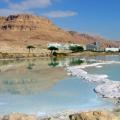According to the reconstruction of the chronology carried out by A.T. Fomenko and G.V. Nosovsky, in the 16th century, Russia stretched over four continents and included the territories of Eurasia, North Africa and more than half of the territory of North and South America.
After the collapse of Russia at the beginning of the 17th century, the rulers of the new states created on its former territories began rewrite history... Such a course of events is no longer surprising to anyone - many are used to it, because history has been rewritten many times in our time and continues to be rewritten further.
Indeed, the opening in those years of two other fronts of the war - that in the Netherlands with its heretics and the Balkans, in order to resist another Turkish expansion on the ground, required a high concentration of resources, goods and assets in Northern Europe, whose wealth could not find obstacles and required a safe sea ...
Travel, geographical discoveries and exploration of the territory in the XVI-XVII centuries
These are the main reasons that led in the early seventies to the opening of the third and decisive stage of the conflict between the Ottoman Empire and the Catholic forces. The need for a final solution to the "Mediterranean issue" in its interweaving of religious and economic motives, the orthodoxy of faith and freedom of trade leads to an acceleration of the collision, which ends with the battle of Lepanto with the borders of the alloy, should be identified in the mutual distrust of the allies. The fleet, under the command of the Spanish admiral Giovanni d'Arsten, begins a slow navigation in search of the enemy.
The interpretation of history necessary for the authorities is a powerful tool for controlling the consciousness of society... The newly minted rulers of the former territories of Russia really wanted to forget about their subordinate position in the past and, more importantly, they wanted to hide the circumstances of their coming to power. After all, the split of a single country took place by overthrowing the legitimate leadership.
The two teams cross each other in Lepanto, off Patras, Greece. The battle is unusual for deployment of force and violence: 230 Turkish and 208 Christian ships collide with the first shots, then armpits and about a thousand Turks are killed. The event is celebrated throughout Catholic Europe, and news of the epoch-making victory over the notorious Islamic enemy is spreading and spreading among the populace through the effective promotion of medals, pamphlets and performances.
However, the myth of the Battle of Lepanto, which also requires further historiography, develops a glory unjustified by the real political and historical consequences of the victory. While it is true that success will lend great credibility to the forces of the Holy League and that the Turkish prisoners will be an effective engine for their galleries, it is also true that the Sultan rebuilt the destroyed fleet the following year.
To give the appearance of the legitimacy of the new government, Scaligerian historians had to come up with myth about the "Mongol-Tatar" conquest of the world. Materials confirming that it is really myth, already there are a lot of people interested, we are sending them to the publications "We drop the charges against the Mongol-Tatars ...", "What was covered by the Tatar-Mongol yoke?"
The Mediterranean in the Sixteenth Century: An Economic Reality
His main merit is to offer a new reading of the events taking place in this ancient commercial center and civilization. The classical thesis argued that the Turkish conquest of Constantinople and the discovery of America corresponded to the automatic crisis and decadence of the Mediterranean world. Throughout the sixteenth century, among other Mediterranean countries, there were economic and commercial oceanic competition. On Lombard silk, in fact, the one produced by Calabria and Genoa in the sixties, at the beginning of the uprising in the Netherlands, became one of the richest cities in Europe, because American silver - to avoid Anglo-Dutch piracy by following the safest Mediterranean routes from Barcelona - he starts to get together.
Considering that the overwhelming majority of the invented "Mongolo-Tatars" were in fact carriers of the genetics of the Rus and they spoke Russian, it is even possible to determine the borders of Russia in the 16th century using official data. To do this, it is necessary to map what the myth-makers from history were ashamed to do. A.T. Fomenko and G.V. Nosovsky do this in their book " Caliph Ivan". They took two maps of Scaligerian historians: 1260 (Fig. 1) and 1310 (Fig. 2) and combined the information from these maps, highlighting the "Mongol-Tatars" Empire in dark color (Fig. 3).
Even in terms of technological evolution, the large-scale spread of the superimposed hull hull, making boats more stable and reliable, reduces the risk of winter navigation. A port such as Ragusa on the Adriatic coast is becoming an important trade and shopping center at the European level.
Its large cargo ships carry Mediterranean salt, a bale of wool, wood, grain and buffalo skins, making the fortunes of various owners scattered throughout the most important cities in Europe. But at the end of the sixteenth century, the situation just described begins to show the first signs of collapse, which will become irrevocable at the turn of the twenty years.

Rice. 1

Rice. 2
It turned out Empire as of the 14th century. 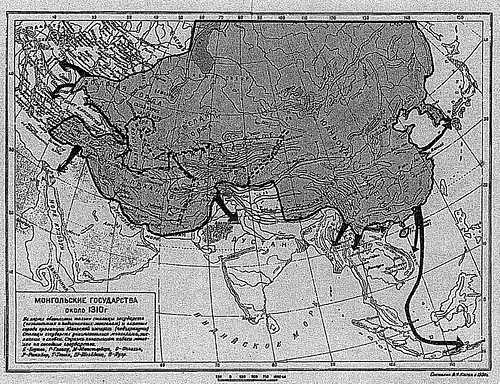
Rice. 3
Further creators new chronology celebrate interesting fact- Scaligerian historians indicate with arrows the further advance of the "Tatar-Mongols" to Western Europe, Egypt, India, Japan, Malaysia, Thailand, Vietnam, Burma, Indonesia, but they are careful to limit themselves to this! There are hiking arrows, but the result of these trips is missing... Like, there is no particular outcome. Such caution is quite understandable, because if this result is plotted on a map, then it will become very impressive. According to the research of A.T. Fomenko and G.V. Nosovsky in the 16th century in The empire also included significant areas of North and South America. The result of the conquest is shown in Figure 4.
The Mediterranean economy, which for a century, despite its defenses, has resisted and is able to develop coincidentally with particularly favorable economic conditions, must keep pace with the new and brutal economies of the Nordic countries. In fact, until the Atlantic economy reaches its internal organization and stability, ultimately the consequences of the rift between the Mediterranean world and the transforming northern economic zone are clear. The factors behind this crisis are different.
Portuguese business is added to Portuguese business, but the "bearers of the sea" show unequal efficiency and inefficiency. With better armed ships, more efficient crews and a practice of piracy and product counterfeiting, they are gradually moving to inland shipping routes. The Dutch have now brought wool bales from Spain to the new port of Livorno, which will later reach Venice. But the decisive blow to the Mediterranean economy is that the Dutch are replacing the Portuguese in the Indian Ocean region.

There are many facts confirming the existence of Russia, huge by today's standards, in the Middle Ages. It is little known, but it is a fact that the French kings took an oath on a holy book written in Old Church Slavonic language, and the Patriarch of Jerusalem presented Charlemagne with a cross, covered with Russians inscriptions.
They then conquer a monopoly on the pepper and spice trade, thereby replacing the Venetians and Turks in the Mediterranean. Italy, a country with a Mediterranean economy for the most part at the end of the sixteenth century shows significant recessionary figures: not only the Venetians are hammering the pace, but also other Italian cities that are excluded from the exchange of new products over long distances, such as Brazilian bacon and juice, tobacco , tea and coffee.
It highlights the millennial weakness in the Mediterranean economy, which in this case and, as always, occurred during the crisis of the system - effective reactivity. With the exception of Venice, which is sufficient to provide the prerequisite for satisfying its annual needs, all the great capitals of the Mediterranean depend on the grain of Puglia, Sicily, Egypt and North Africa... In the middle of the century, the first crisis crisis was overcome by turning to the corners of the Black Sea region controlled by the Ottomans and the Baltic regions controlled by Dutch traders.
Another very illustrative example is given in the book by A.T. Fomenko and G.V. Nosovsky " Tatar-Mongol yoke: who won whom "... Distances from the capital of Russia - the city Vladimir- to many capitals and cities of now other states, and earlier governorships in the territories of the colonies of Russia, obeys a certain pattern.
But this effort, dictated by the need to supply grain and feed the big capitals, is facilitating the entry of northern sailors into the Mediterranean. In the 1990s, a recurrence of bad collection and a decline in exports in Sicily was the starting point for the abolition of economic relations between Northern Europe and the Mediterranean world. A real invasion that brings with it the inevitable load dependence. Before the crisis, trade with the Nordic countries was limited to luxury products such as pepper and silk in exchange for metals and timber; now the need for grain makes it unprofitable for the centuries-old economic trend favorable to the Mediterranean countries.
In order to determine what kind of regularity is observed in the distances from the capital of Russia to " regional centers", Let's put ourselves in the shoes of the conquerors. But before doing this, we note one important circumstance - the level of civilization development of the annexed territories was much lower than the level of Russia (some lands were practically not inhabited), therefore large settlements we, as conquerors, will have to build by ourselves.
This is what Browdel describes as "the sixteenth century." Bohemians have been proud of the card of the young doctor Nikolai Claudian since 1950, Johan Kriginger is working on his work. Half a century later, the map was carefully revised by the "teacher of the peoples" Jan Amos Komensky. Their cartographic representation was bound to consist in the absence of good maps.
Moravia Jan Amos Comenius traveled much more. The native of Moravian Slovakia knew the country well thanks to his own autopsy. As the last bishop of the Unity of the Brotherhood, he was forced to leave Moravia for religious reasons. Not only the personality of the author, but also the quality of the measuring, cartographic and artistic processing made Comenius one of the most popular cartographic works of the Czech lands of its time.
In such an environment, it would be reasonable to place the centers of the new governorships along the trade routes created at that time at a certain distance from the center of Russia (Fig. 5). And so it was done.
This distance was chosen for reasons of establishing optimal communication in the field of trade, mail, and so on.
Many capitals lie on two circles with the center in the city Vladimir(fig. 6).
The oldest edition of the map comes from the year. For more than 150 years, there have been more than a hundred different editions on the map. The presses were issued by publishing houses in the Netherlands, Germany and Italy. Cartographic prints have found their firm place in cartoon atlases by Claes Visscher, Willem Bleo and Yodok Hondia. The popularity of the work is also confirmed by the overthrow of the notorious withdrawal of the map of Fabricius of Moravia from the hands of Peter Caerius, who signed the map in the name of Comenius. The Comenius cartographic rendering of Moravia appeared, for example, at the heart of five card games.

Rice. 6
The first circle with a radius of about 1800 km. The following cities are located on it: Oslo, Berlin, Prague, Vienna, Bratislava, Belgrade, Sofia, Istanbul and Ankara. Second circle with a radius of 2400 km. It houses London Paris, Amsterdam, Brussels, Luxenburg, Bern, Geneva, Rome, Athens, Nicosia, Beirut, Damascus, Baghdad, Tehran. And what is typical, if you take any of the listed cities except Vladimir and make it the center of Russia, then nothing of the kind will happen.
The answer to the question about the purpose of the Comenius map was not entirely clear. Although there is a surviving copy of the maps located on 18 sheets and stored in a leather case, this is rather a unique case of using the map as a travel aid. In most cases, the map was collected in large atlases, it is difficult to find practical application on the road. During the troubled period of the war, the map could equally represent a strategic document for military campaigns. This is also explained by the detailed drawings mountain passes, bridges and fords across rivers, as well as a rich map display.
Hence, we can conclude that the name of the city of Vladimir has a very definite meaning - “ Owning the world».
Falsification of history
After the collapse of Russia into smaller states, the new European authorities began to falsify their history, and their protégés in the rest of the Russian state - Romanovs- began to rewrite the history of the Russian people. The falsification was full-scale. Europeans came up with biographies of their rulers and new languages, magnified their contribution to the development of civilization, renamed or distorted geographical names. The Russians, on the contrary, began to instill thoughts about the worthlessness of the Russian people, books containing a true story were destroyed, and instead they made fakes, culture and education were distorted and destroyed. The geographical names familiar to the Russian ear from Europe migrated to remote areas in the territory of Russia. And this, of course, is not all. Here are some indicative facts.
The motivation for creating a new and more accurate map of Moravia can be found in Comenius in an attempt to correct human affairs, as well as inaccuracies and errors in the maps of his predecessors. In his own words, he continued to consider old card Fabricius in the "involuntary void" in which he found himself in exile.
We learn from how the maps of two authors were created. First, both countries have traveled many times, perhaps with simple instruments. Especially when it comes to local issues. Zerotin's favor may have opened the door to numerous archives for Comenius.
Kings of Europe were written off from Russia
Imagine the situation: the empire has been destroyed, new and, as they say now, “not shaking hands” authorities in the breakaway territories. What should they tell the new generation? The truth? No, we ourselves are disgusted to remember that they were in a subordinate position and came to power not according to the law. We'll have to invent a past for ourselves. And certainly great. To start came up with the rulers... The simplest and most reliable option is to take as a basis the biographies of the ruling dynasties of Russia and, on their basis, create fake stories of their monarchs and kings, but only with different names and with life events tied to the conditions of the newly-made states.
Comparing the positional accuracy of the maps with current maps has revealed some of their structural weaknesses. By way of illustration, the positional display accuracy of both maps ranges from five to seven kilometers with local specificities. Maps are oriented from the geographic meridian to the east. This is probably the result of a false identification with the magnetic meridian. First of all, the region of western, southern and northeastern Moravia, together with Silesia, shows signs of significant positional deformation.
On the other hand, relative accuracy is achieved by the distances between the main Moravian cities. It is a connecting line between Znojmo, Brno, Kromeriz and Nowy Jicin. In the case of the Comenius map, this imaginary line extends to the southwestern part of Moravia, and on the other to Silesia. The distance of the map on the map corresponds to the actual values. Most of the settlements and their varied structure can be found in these parts of both maps. From Vienna to Moravia, Fabrice painted towns and villages along two main routes in the direction of Znojmo and Mikulov.
This is how the Western European dynasty appeared Habsburgs, which is written off from the dynastic stream of the kings-khans of Russia of the 13-16 centuries. Detailed description this basic dynastic parallelism is given in. We will confine ourselves to two drawings from the above book. Figure 7 shows "the correspondence between the Russian-Horde dynasty of the 13-16 centuries and the Habsburg dynasties of the 13-16 centuries."
It is difficult to prove whether the distances themselves were measured by the authors themselves, although they already had the appropriate instruments. A car with a wheel speed measuring mechanism, the so-called viatoria, was later used by cartographers and authors of maps of Moravia Jiří Matthias Viscera and Jan Krishtof Müller. Traveling routes could also serve as a useful tool not only in travel but also in building maps. The recorded scale of miles, with the lengths of the Moravian and geographical miles used at the time, is proof.
Both well-educated trainees were well aware of their own experiences. From Vienna through Brno and Ostrava to Krakow, Poland, the so-called Krakow trade route passed. The cartographic representation of Comenius' Moravia is undoubtedly superior to the maps of its predecessors.

Rice. 7

Rice. eight
Figure 8 shows "the correlation of the durations of the reigns of the Russian-Horde kings-khans of the Great =" Mongolian "Empire of the 13-16th centuries and the rulers of the Habsburg Empire of the 13th-16th centuries." In order to recognize the "dynastic clones" this is quite enough. But the book also contains unique repetitions in the events of life. clones and their prototypes.
Gothic is a Russian style
An interesting metamorphosis of architectural styles took place in the 17th century. In it is indicated that with the coming to power in Russia of the Romanovs, there was a change in architectural styles. Moreover, the introduced samples were then issued for "typical ancient Russian". As a result, today's ideas about what Russia looked like before the 17th century are in many ways completely wrong.
Now we are assured that the usual appearance of the church is exactly what we see in our time: a roughly cubic building with an almost flat roof, from which one or more domed drums rise. An example of a "typical appearance" of the Russian church is the Nikolskaya church in the Nikolo-Uleimensky monastery near Uglich (Fig. 9).

Rice. nine
Such churches strikingly different from cathedrals Western Europe(for example, the Gothic Cologne Cathedral, Fig. 10). This difference was artificially implanted.

Rice. ten
It was beneficial to the falsifiers of history, since they needed to show that there was nothing in common between Russia and Europe.
However, A.T. Fomenko and G.V. Nosovsky cites facts that show that until the 17th century, the main architectural style in Russia, as well as in its European provinces, was the Gothic architectural style. This suspicion first arose in them while studying the old architecture of the churches of the famous Russian city of Uglich.
It turned out that all churches cities, with one exception, either rebuilt or substantially rebuilt not earlier 17th century... The remake has a familiar form for us (Fig. 9).
The only exception is the famous Church of St. Alexei, Metropolitan of Moscow in the Alexeevsky Monastery. It is believed to have been built in 1482 year and remained in its original form - a house with a high gable roof, on which three towers-spiers rise (Fig. 11, Fig. 12). The similarity of the architectural style of this church with the Cologne Cathedral is striking (Fig. 10).

Rice. eleven

Rice. 12
A reasonable question arises: there is a church of the 15th century, 17th century and later, too, but where are the churches of the 16th century? Didn't they build anything for 100 years or did they fall apart "by themselves"? The fact is that the Church of Metropolitan Alexei is a large cathedral of the 15th century, one of the largest in Uglich so far. Having built such a cathedral in the 15th century, the Uglians had to build something in the 16th century! Quite justifiably, the impression arises that all the churches of Uglich in the 17th century were rebuilt anew, and only the Church of Metropolitan Alexei, by the will of fate, remained and is now a "black sheep" among the remake.
In support of their assumption, the authors of the book give the following example, for which they turn to the architecture of the famous old Russian Nikolo-Uleimensky monastery near Uglich. There are two churches there. One of them - old the church of introduction (fig. 13, fig. 14).

Rice. 13

Rice. fourteen
Unlike the new, "typically ancient Russian", the old is gable roof house which is reminiscent of the gothic style. Later in 17th century, a "four" was added to it and a bell tower was built on.
There is a clear feeling that in the 17th century the overwhelming majority of the old Russian-Horde churches were rebuilt according to the reformist “Greek model”. Moreover, it was stated that so it was.
In some places in Russia, by inertia, they continued to build Gothic cathedrals even up to the 18th century. For example, church Peter and Paul in Yaroslavl (Fig. 15), attributed to the years 1736-1744.

Rice. 15
A mosque was erected in the same style in the village of Poiseevo in the Aktanysh region of the Republic of Tatarstan (Fig. 16).
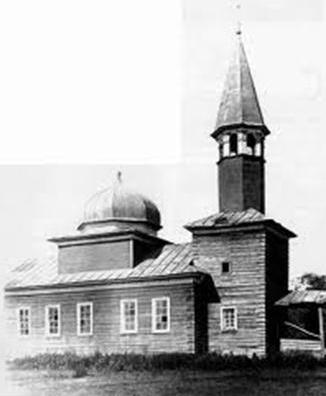
Rice. 16
But in the end, under the Romanovs, the Gothic style was supplanted and forgotten. Churches of this type were either destroyed and rebuilt, or tried to change their appearance with extensions, or adapted for other needs. For example, household. A striking example is the old long huge house with a gable roof, standing in the New Simonov Monastery in Moscow (Fig. 17), which in the 19th century was used as a grain dryer.
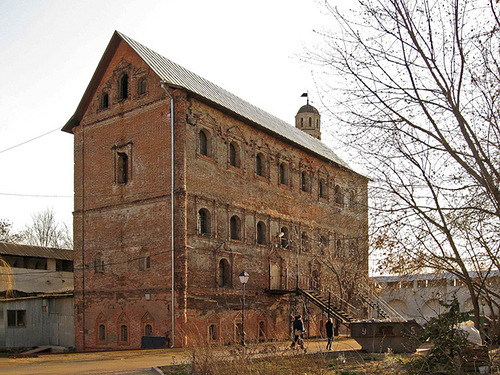
Rice. 17
Its architecture exactly matches the look of the old Russian churches-houses. Perhaps this is the former church of the monastery.
Other examples of churches in the Gothic architectural style:

Rice. eighteen
- The old Russian church in the village of Bykov (Fig. 18);
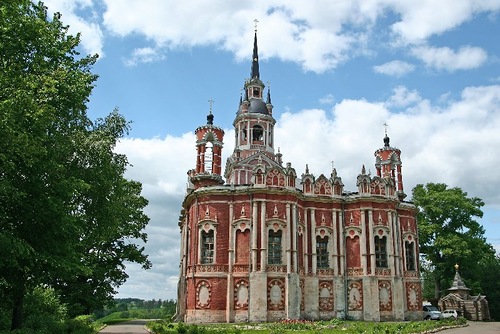
Rice. 19
- New St. Nicholas Cathedral in the Mozhaisk Fortress in 1814 (Fig. 19);

Rice. twenty
— Old church in the Luzhetsky monastery of Mozhaisk, which probably also looked like a Gothic house (Fig. 20);

Rice. 21
- Mosque in Starye Kiyazly, Republic of Tatarstan (Fig. 21);

Rice. 22
- A mosque in Nizhnyaya Oshma, the Republic of Tatarstan (Fig. 22).

Rice. 23
And in conclusion of this topic, we will give one example of the correspondence between the styles of the Russian and German churches. Figure 23 shows the German church Clementskirche in Mayenne, near Bonn.
Its dome is made in the form of spirals twisting upward. The dome of this shape is believed to have been created between 1350 and 1360. The reasons for this design of the dome are firmly forgotten, and instead of them a story was invented about the devil who twisted this tower in a corkscrew.
According to the authors, in fact, here we are faced with the old style of Russian-Horde architecture of the 14-16 centuries. If we compare the dome of the German Clementskirche with the spiral domes of St. Basil's Cathedral in Moscow (Fig. 24), we will immediately understand that here and there are the same style.

Rice. 24
Minaret towers decorated with spirals have also survived in the East and Asia ...
The organ is a Russian instrument
Scaligerian historians paint the image of a Russian person in the form of a rude man in sandals and earflaps. It goes without saying that about any high culture in general, and musical in particular, there is no talk. All that is allotted to us is simple dances around the fire, primitive obscene ditties, a tambourine, spoons, the squeaky squeak of pipes and the strum of a balalaika, in extreme cases - a gusli. All this is infinitely far from the exquisite Versailles with lace, violins and organs.
In fact, this is not the case. Take an organ, for example. Before the arrival of the Romanovs in Russia, the organ was a widespread instrument, but with their coming to power, a struggle began with the Russian cultural heritage — authorities banned... And after replacing Peter I with a double, the total eradication of organs even from the Russian household began!
Let us turn to the testimonies of contemporaries of the "cultural cleansing", which cited A.T. Fomenko and G.V. Nosovsky in his book.
In 1711, "A Journey through Muscovy to Persia and India" by the Dutch traveler Cornelius de Bruin, who had been to Moscow in 1700, was published in Amsterdam. Simultaneously with him in Moscow there was an Italian Philip Balatri, who “to his surprise, discovers: many houses have organs original design, but for some reason they are hidden in closets. Later it is possible to find out: Peter forbade them as a legacy of ancient Russia. The jester Shansky's wedding near Kozhukhov in 1697 was almost the last Moscow folk festival with 27 bodies…».
“The music makes no less impression. De Bruyne can hear it everywhere - oboists, horn players, timpani players in the military ranks and during solemn processions, whole orchestras of a wide variety of instruments up to the organ at the triumphal gates, on the streets and in houses, and finally, the surprisingly harmonious sound of singing ensembles. Not a single holiday in Muscovy could do without this.».
“… With the founding of St. Petersburg, the number of organists among free musicians sharply decreased. There are still organists in Moscow, and there are almost no organists in St. Petersburg. Fashion and personal taste of Peter I did their job. The death affected Moscow fire 1701 year the old, superbly established Kremlin organ and harpsichord workshop. They did not restore it - Peter had different tastes for the very construction of the Kremlin. Nobody began to take on the new workshop. Fewer musicians have become among the owners of Moscow courtyards. Unemployment? Poverty Creeping Up? It is not so difficult to verify by another type of accounting for the life of the townspeople - the carefully registered and taxed deeds of sale and purchase. And this is what opened: organists changed their profession…»
And in the West, the organs have survived to our time and they were retroactively declared an exclusively Western European invention ...
Germany is Great Perm
Let us once again put ourselves in the place of history falsifiers who are trying to hide the great past of Russia.
The empire collapsed, and many names of cities and territories of the breakaway provinces sound in Russian language and firmly entered the annals. What to do? It is possible to destroy all the chronicles and prohibit the use of the old names of European provinces. Is it effective? No - long and time consuming. It's easier to take a well-known name, make a sign with the words “city N "And put it in some wilderness, announcing that it has always been this way. And the Europeans themselves will happily forget about the Russian influence. And so they did. Therefore falsification geographic location touched not only the "Mongols" with Mongolia, which was moved on paper to the border of China. In provides very interesting information about which territory was actually called Great Perm.
Chronicles are often mentioned about the Perm land, in which it is reported that it is - militarily powerful state, very wealthy... It is located near Ugra. Ugra is Hungary in Old Russian. In Russian, Ugrami is the name for the peoples who speak the Finno-Ugric languages. In the history of the Middle Ages, only one militarily strong Ugric state is known - this is Hungary. It is believed that the Perm land was finally annexed to Russia only in the 15th century.
The book cites the following chronicle information somewhat distorted by modern historians: “The Novgorodians, making military-trade campaigns to the Ugra land through the Permian land ... approx. Nosovsky and Fomenko) to pay tribute. Since the 13th century Perm land constantly mentioned among the Novgorod volosts... Novgorod "men" collected tribute with the help of centurions and elders from the top local population; continued to exist and local princes who retained a certain degree of independence ... the Christianization of the region, carried out by the bishop Stefan Permsky(in 1383 ... founded Perm diocese, compiled the alphabet for zyryans) ".
“In 1434 Novgorod was forced to cede in favor of Moscow part of its income from the Perm land ... In 1472, Moscow was annexed ... Perm the Great…local princes were relegated to the position of servants of the Grand Duke. "
Thus, the Perm land had its own princes, who were independent sovereigns until the 15th century. She had her own bishop and her special alphabet.
And what do the Scaligerian historians tell us? The Great Soviet Encyclopedia indicates: “ Perm land- the name in the Russian chronicles of the territory west of the Urals along the Kama, Vychegda and Pechora rivers, inhabited by the people komi(in the annals - Perm, Perm, and zyryane) ".
At first, the Komi people living along the Kama River (Komi and Kama are the same root words) do not call themselves either Perm or Zyryans! These names were assigned to the Komi already under the Romanovs. The fact is that the city of Perm until 1781 was just a village and was called ... Egoshikha! According to official data, the village of Yegoshikha appeared in the 17th century. The name Perm was given to Yegoshikha shortly after the suppression of the "Pugachev rebellion", which in fact was nothing more than civil war between Muscovy and Great Tartary, after which Great Tartary ceased to exist and the memory of her was destroyed. In the same year as Permian- 1781 - appeared and Vyatka, but this is a topic for a separate story ...
Secondly, the above encyclopedia says that "the Komi people did not have their own written language." According to other sources, for worship in the Komi language in the 17th century, a writing based on the Cyrillic alphabet was used, but not the alphabet of Stephen of Perm! Where did the alphabet go and why does no one there remember the enlightener Stephen? Yes, there was no special alphabet in Yegoshiha Stefan, but more on that below.
ThirdlyThe Great Soviet Encyclopedia informs that “the economy of the Komi Territory remained natural for a long time ... in the 17th century there were only two settlements Yarensk and Turia, one trading village Tuglim ... Only gradually, in the 17th and especially 18th centuries, did trade develop and take shape local markets ". By the beginning of the 20th century, "the Permian Komi were a small nation ... doomed to the complete loss of their national culture ... During the years of Soviet power, a literary language and writing were created." Are there any signs of a militarily powerful and wealthy principality? We do not observe them at all. There was nothing to reign over there until the 17th century - Yegoshiha was not even there.
Fourthly, take a map of Europe and see how the Novgorodians (Novgorod is Yaroslavl) made "military-trade campaigns to the Ugra land through the Permian land" (that is, to Hungary) and recall the strange story of Karamzin: "The Mongols more and more spread their conquests and through Kazan Bulgaria we reached Perm itself, from where many inhabitants, oppressed by them, fled to Norway. " What are these "zigzags of luck"?
Great Perm, we emphasize the word "Great", which clearly indicates its great importance, could not be where it was placed under the Romanovs.
Where was she then? A.T. Fomenko and G.V. Nosovskiy provide a justification for the fact that Great Perm is in fact the territory of southern Germany, Austria and northern Italy.
This is indicated by some obvious traces in place names. For example, in Northern Italy it is known old City Parma, the name of which clearly sounds Permian... And in the capital of Austria, Vienna, there is still St. Stephen's Cathedral (Fig. 25).

Rice. 25
Maybe it was the famous Stefan of Perm, the educator of Perm? The word Germany is possibly a variant of the word Perm.
Then it becomes clear why the alphabet of St. Stephen was forgotten in the history of the Komi people and the village of Yegoshikha. And here we can assume that this alphabet was Latin and it was it that was distributed among the Europeans for the cultural demarcation of Europe and Russia ...
-----------------------
Caliph Ivan / A.T. Fomenko, G.V. Nosovsky. - M .: Astrel: AST; Vladimir: VKT, 2010 .-- 383 p.
Tatar-Mongol yoke: who conquered whom / A.T. Fomenko, G.V. Nosovsky. - M .: Astrel: AST; Vladimir: VKT, 2010 .-- 380 p.
« Advisor»- a guide to good books.
From the article by Alexei Kulagin "The split of Russia".
The successor of Ivan III, his son Vasily III, continued the policy of uniting the Russian lands. During the years of his reign, the long process of joining the Pskov Republic to the Russian state was completed (1510). A military threat looming over southern borders from the side of Lithuania, forced Vasily III to hasten with the elimination of Starodub and Novgorod-Seversky inheritance and annex the Ryazan principality (1521).
The Russian troops won a major victory in the war with the Grand Duchy (1512-1522). After a three-month siege in 1514, Smolensk, an ancient Russian city and the most important fortress on the western borders, was taken.
The need for defense against constant attacks on the eastern borders of the Kazan feudal lords, the interest of peoples in joining Russia, prompted the Russian government to speed up the solution of these issues. Of great importance was the fact that the Kazan Khanate in every possible way prevented the expansion of the ancient economic and cultural ties of Russia with the peoples. Central Asia, Caucasus, Western Asia and Siberia. The annexation of the Volga region also opened up new opportunities for providing land to the nobility.
In 1546, the people who inhabited the right bank of the Volga voluntarily joined Russia, and on October 2, 1552, the Kazan Khanate ceased to exist. Soon, Western Bashkiria, formerly subordinate to the Kazan khans, entered Russia. After the annexation of the Astrakhan Khanate in 1556, the Volga along its entire length became the main waterway of Russia. This opened access to, and at the same time the possibility of relations with China. In 1557, the annexation of the Volga and Western Urals was completed, and the principality of Kabarda was accepted into citizenship.
The successful solution of defense issues allowed the Russian state to begin the struggle for an exit to gain free access to European markets. However, the Livonian War, which lasted a quarter of a century (1558-1583) and cost enormous sacrifices, did not solve this historical problem. As a result of the war, Russian territory with the cities of Koporye, Yam, Ivangorod and the entire coast Gulf of Finland, except for the mouth of the Neva were captured. According to the Tyavzin Peace Treaty of 1595, after the war with Sweden in 1590-1593. these territories were returned to Russia.
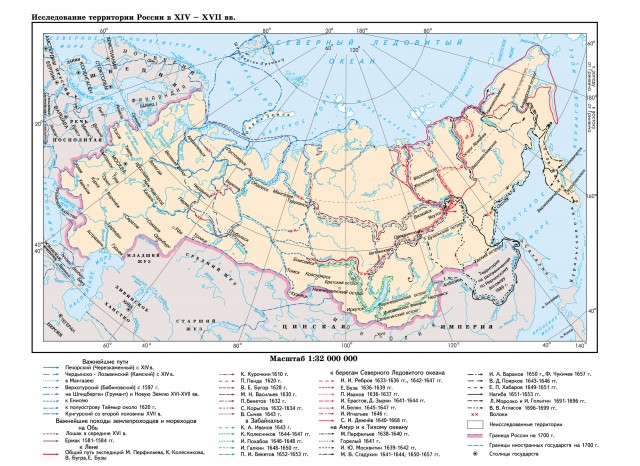
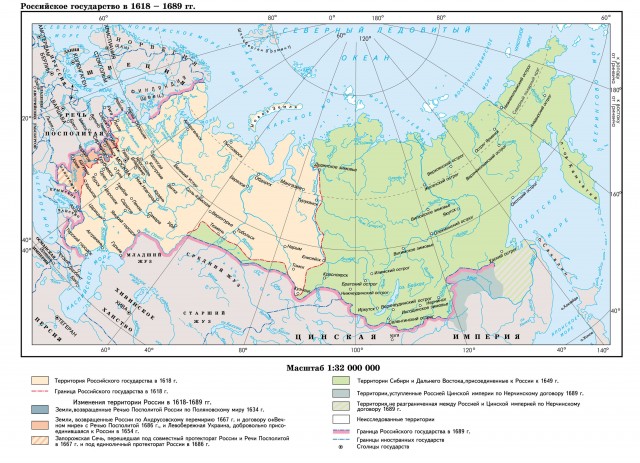
Ermak's campaign in 1581-1584 beyond the Ural ridge marked the beginning of the fall of the Siberian Khanate and the annexation of Siberia.
Ladoga area. According to the Deulinsky truce of 1618 after the Polish intervention in 1604-1618. ceded According to the Stolbovsky Peace Treaty of 1617, Sweden retained the Izhora land, the Neva, and the Commonwealth of Chernigov, Seversk and Smolensk lands, the cities of Przemysl, Serpeysk, Trubchevsk, Pochep, Nevel, Sebezh, Velizh.
Russia in 1618-1689
In the years 1632-1634. An attempt was made to return the seized lands, but according to the Polyanovsky Peace Treaty of 1634, only Serpeysk with the district was returned to Russia, and in 1644, during land surveying, it received the city of Trubchevsk.
In 1647, an uprising against the Polish-Lithuanian Commonwealth (Poland) began, which grew into a war of liberation, which ended with the Pereyaslav Rada on January 8, 1654, which announced the voluntary annexation of Ukraine to Russia. The entry of Ukraine into Russia led to a new war with Poland. The long war, accompanied by a break, ended with the signing of the Andrusov Treaty in 1667. Russia received back the Chernigov, Seversk and Smolensk lands, the cities of Velizh, Nevel, Sebezh, and for two years Kiev and the district. A joint protectorate with Poland was established over the Zaporizhzhya Sich. In 1678, an addendum to the Andrusov treaty with Poland was signed, according to which Russia ceded the cities of Velizh, Sebezh and Nevel to Poland.
According to the eternal peace with Poland (1686), Russia finally received Kiev with the district and the sole protectorate over the Zaporizhzhya Sich, but ceded to Poland the area along the banks of the river. Sozh (Posogye).

By 1649, the annexation to Russia was completed Eastern Siberia and the Far East (after the campaigns of F. Popov and S. Dezhnev, V. Poyarkov, E. Khabarov, etc.).
Penetration of Russians on Far East inevitably led to a clash of interests between Russia and the Chinese Qing Empire. In 1689, the first Russian-Chinese treaty was concluded in Nerchinsk, according to which Russia ceded the lands of the Albazin province along the upper reaches of the Amur and the right bank of the Argun. The border line under the Nerchinsk Treaty was extremely vague. The territory between the basin of the Uda River, the Amur and the ocean was left undivided.
Travel, geographical discoveries and exploration of the territory in the XVI-XVII centuries.
It was a time of major geographical discoveries in the western sector of the Arctic, where the Pomors explored the coasts of the northern seas in detail. With the development and expansion of navigation areas, the accumulation geographic information already in the second half of the 16th century. (or even earlier) handwritten Pomor sailing directions and handwritten maps appear at the helmsmen of Pomor ships.
Along the sea shores, a sea route was laid and studied in detail by generations of Russian sailors and industrialists, connecting the mouths of the Kola, Onega, Northern Dvina and Pechora rivers, and regular navigation was established between the Northern Dvina and Pechora rivers.

The government and industrialists organized large trips to Siberia in order to seize the enormous wealth of fur and in search of precious metal ores. Overcoming enormous difficulties, the Cossacks and industrialists moved from the Ob River along the waterways on kochi (small sailboats), passed by drags from one pool to another. Extending their power to the vastness of Eastern Siberia, the Russians set up forts, ostrozhki, winter huts as strongholds on the Lena and its tributaries.
In 1616, the Tobolsk voivode, reporting to Moscow information about the sea route to Mangazeya, at the same time expressed fears that the Germans could use it to trade with Siberian foreigners and that such attempts had already been made. In the same year, the Moscow government was under fear death penalty forbade going by sea to Mangazeya.
At the beginning of the 17th century. Russian industrialists reached Taimyr. In the years 1620-1623. they reached the middle reaches of the Lena River and the headwaters of the Lower Tunguska. In the years 1630-1635. the rivers Aldan and, the upper and, the Leno-Angarskoe plateau, the mouth of the Lena, and the rivers Olenek and Yana, the mouth of the Indigirka were discovered.
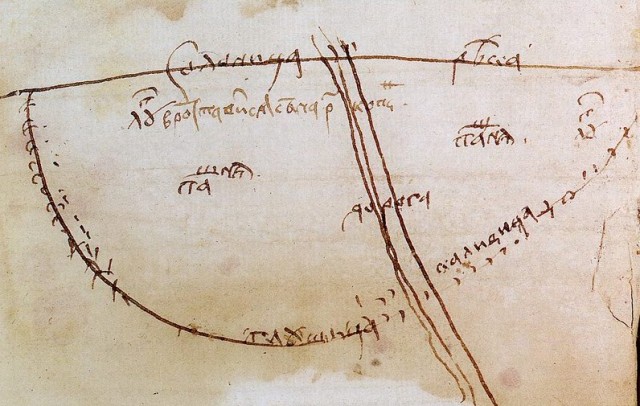
In 1638, the D. Laptev Strait was discovered, and the river. Indigirka (I. I. Rebrov), b. Vitim (I. Perfiliev). In 1641 M. Stadukhin sailed from Oymyakon down the Indigirka and then reached the Kolyma River by sea.
The Pacific Ocean was first reached by the Russians in its southern part - c. In the years 1639-1641. I. Yu. Moskvitin discovered the Sea of Okhotsk, the mouth of the Amur River, Sakhalin Bay, Sakhalin Island, etc. The first maps of the coast of the Okhotsk (Lama) Sea were compiled by K. A. Ivanov no later than 1642 on the basis of the expedition of I. Yu. Moskvitin ... These drawings, apparently, died, but information about such a drawing was preserved in K. A. Ivanov's petition.
K. A. Ivanov in 1643 reached. The first description of it was carried out during the campaign of N. Spafari and N. Venyukov (1675-1677).
In 1643-1646. V.D. Poyarkov and in 1647-1651. E. P. Khabarov made campaigns to the Amur.
From 1643 to 1649 the Khatanga Bay, the Anabar and Popigay rivers (V. Sychov), parts of the coast were discovered East Siberian Sea, Chaunskaya Bay and Ayon Island (I. Ignatiev-Mekhenets).
In 1648, the expedition of S.I.Dezhnev and F.A.Popov passed from the mouth of the Kolyma around the peninsula in and then reached Kamchatka, thereby opening the strait connecting the Arctic and later named Bering.
In the years 1691-1699. L. Morozko, I. Golygin and V.V. Atlasov made hikes.
Territory mapping in the XVI-XVII centuries.
At the end XV-early XVI cc. In the Russian state, an abundant and varied geographical material is accumulated, which has made up three main groups of sources: scribes, descriptions of border lands, and road builders.

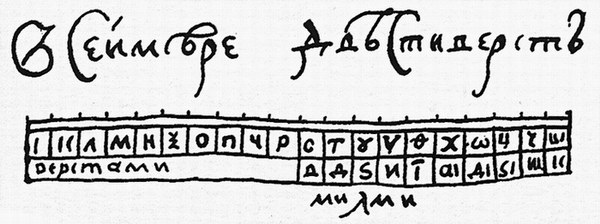
The manuscript department of the Russian State Library houses the oldest Russian cartographic monument, made on paper and dating back to the 1530s. This is a drawing of lands along the Solonitsa River, pasted into a manuscript book from the library of the Trinity-Sergius Lavra, schematically depicting a small section of the right bank of the Volga slightly above Kostroma.
Drawing up drawings in central government bodies and in the field became commonplace in the practice of the Russian state in the 16th-17th centuries.
Almost the entire western border of the state from the Arctic Ocean to Putivl and Chernigov was represented by a number of local drawings. B.A.Rybakov believed that some of these drawings can be dated by the most early XVI v.
Relatively large-scale cartographic materials created for solving specific practical problems and reflected in the surviving inventories of drawings were rare and fragmentary. Text descriptions covered almost entirely the European part of the country and constituted the main material for overview mapping. In the second half of the XVI century. almost all the lands that were part of the state were subjected to similar descriptions, and some several times. Descriptions were carried out even along the coast, in Livonia, Polotsk, Pskov, Novgorod, Olonets, Vyatka, Cherdyn and Soli-Kamskaya.
There are many foreign maps of Russia, the content of which testifies to the use of Russian descriptions and maps in their compilation. A detailed analysis of the sources of foreign maps on the basis of a deep study of the history of their creation and the historical and geographical content allowed B.A.Rybakov to put forward a bold hypothesis, which consists in establishing the date and reconstruction of the content of the first map of the entire Russian state, which he conditionally called the Drawing of the Moscow Lands 1496-1497 biennium BA Rybakov argued that this hypothetical drawing was one of the main sources of the map of Muscovy by Anthony Jenkinson, known at that time from the editions of Ortelius in 1570 and De Yode in 1578. Thus, Anthony Jenkinson used Russian cartographic documents.
The next all-Russian map in terms of the time of creation, according to B.A.Rybakov, is an unpreserved drawing, created in 1514-1535. (most likely in 1523) and later served as the basis for Tsarevich Fyodor Godunov for his drawing in 1600, and also used in 1525 by B. Agnese and in 1613 by Gessel Gerrits.
In 1525, D. Gerasimov, who went with an embassy to Denmark from the mouth of the Northern Dvina, was sent by the Moscow envoy to Rome. In a conversation with the Italian historian Paulo Giovio D. Gerasimov expressed the idea of the possible existence of a route from Europe to China along the northern seas and showed Giovio his blueprint. The Italian cartographer and engraver Battista Agnese reproduced it, and now the drawing by D. Gerasimov, revised by B. Agnese, is considered the first, the most ancient map... In 1525, Giovio in Rome published a book in which, according to the Russian ambassador, Muscovy was described in detail, including the idea of D. Gerasimov.
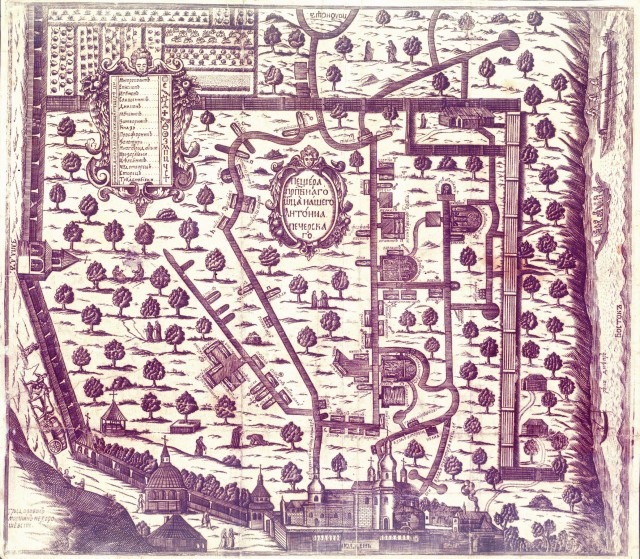
The first European map of Muscovy, for which there is a direct mention of the participation of a Russian in its compilation, is the map of Anthony Weed, drawn with the help of the boyar IV Lyatsky in 1542 with Latin and Russian inscriptions. This work was published in 1555.
The first documentary evidence of the creation of a survey refers to the second half of the 16th century. Thus, Ivan the Terrible laid the foundation for large-scale cartographic work on a nationwide scale.
Under Ivan the Terrible, numerous servicemen and merchants, the first, were sent to the east. From their travels, they brought detailed paintings of the path and drawings - schematic drawings, plans, on which the path was marked, indicated the distances.
At the very end of the XVI century. in the Discharge Order (the highest government institution in Moscow in charge of military affairs) the so-called Great Drawing of the entire Moscow state for all neighboring states was drawn up.The author of the Drawing was a certain A. Mezentsov, and work on this map was supposedly completed by him in 1598. The size of the drawing was 3 arshins (2 m 14 cm), scale - 75 versts in one vershok (1: 1,850,000).
The large drawing as well as its copy, made in 1627 with the addition southern territories up to the Crimea, have not survived to this day. However, the content of these works can be judged by the Big Drawing, known in many copies of the Book, which is an explanatory text created in the same 1627 to a copy of the Big Drawing and its addition. Judging by the Book, the geographical coverage of the Big Drawing was very significant: in the east it shows the territory up to the Ob, in the west - up to the Dnieper and Western Dvina, in the north-west - up to the Tana river, and in the south it covered the territories of Bukhara and Crimea. as well as separate territories of Iran and the Tours land
The Book of the Big Drawing included Painting on sea rivers on the coast of the Arctic Ocean.Its compilers made a great contribution to geographic knowledge his time, describing the sea coast from to the mouth of the Ob.
Administration of Tsar Alexei Mikhailovich in the 60s XVII century carried out intensive work on survey mapping of the Moscow state and its individual parts. According to the testimony of V.N.Tatishchev, under Tsar Alexei Mikhailovich, a general Russian land card and several particular ones were made, and from the general it is clear that the writer Latin language he understood, for he put many Latin words and divided them by degrees ... In the same period, by order of Tsar Alexei Mikhailovich, the Caspian Sea and the Volga River were put on the map. The most striking evidence of the extensive cartographic work of this time are two Tobolsk drawings of Siberia, which are the earliest surviving Russian generalizing maps of the 17th century.
The first of them, the Drawing of Siberia (1667), is usually called Godunovsky, since the inscription to it says that the drawing was drawn up at the discretion of the steward and governor Pyotr Ivanovich Godunov and his comrades. The drawing shows a huge territory east of the Volga and Pechora, including all of Siberia and the Far East.
The second Siberian drawing by many researchers dates back to 1672-1673. It is called the Drawing of the whole of Siberia before the Chinese kingdom and before Nika. Its compiler is unknown, and the drawing itself has much in common with Godunov's map of 1667, but its content is somewhat more detailed. The description to it contains extremely valuable historical and geographical information, confirming, in particular, that the voyage of SI Dezhnev in 1648, bypassing, was repeated by Russian sailors.
A number of domestic cartographic works have survived to this day, testifying to the wide geographical coverage and thematic diversity of cartography in the Russian state at that time. Well known and thoroughly investigated: Drawing and Cherkasy cities from Moscow to Crimea (about 1670); Map of Russian and Swedish cities (circa 1656) covering northwestern Russia and the Baltic Sea; a large road map of European Russia approximately south of the parallel of Moscow (circa 1685) and some others.
The overwhelming majority of Russian cartographic works of the 17th century. represented by relatively large-scale regional geographic drawings dedicated to individual cities and fortresses, routes of communication and land holdings. In the decree of 1670 on the description, measurement and land surveying of the land of the city of Bogoroditsk, it was for the first time prescribed by law to draw up a drawing for the land to be occupied (before that, drawings were drawn up only for disputed possessions).
A special type of ancient Russian cartographic images are geographical plots in works of icon painting. Almost all images of the so-called local saints, in whose names there are geographical names (Zosima and Savvaty Solovetsky, Macarius Zheltovodsky, etc.), also contain cartographic elements, presented, as a rule, perspective view founded by the saints of a monastery or desert, sometimes combined with a plan, sometimes having the names of various objects of the area.
The first domestic printed maps were published in the remarkable monument of Russian Orthodox literature, the Paterik or the Otechnik Kiev-Pechersky (Kiev, 1661). The maps were made by the engraver Ilya from the originals compiled in 1652-1665, and have the names: Image of the cave of our Reverend Father and Image of the cave of the Reverend Father Anthony. In addition to these drawings, the first printed Russian maps include the plan of Moscow on the frontispiece of the Bible, published by the Moscow Printing House in 1663.
The development of domestic cartography in the pre-Petrine period resulted in the outstanding works of the talented Siberian scientist, author of works on geography, ethnography and the history of Siberia, a gifted cartographer, architect and artist S.U. Remezov. He compiled three remarkable collections of maps, drawings and drawings: the Drawing Book of Siberia (1697-1711), the Chorographic Drawing Book (1697-1711) and the Service Drawing Book (1702-1730), completed by his sons.
S.U. Remezov in 1697-1698 a drawing of the Greater Siberia was compiled By 1701, regional drawings and plans of cities were ready, which S.U. detailed the historical and geographical characteristics of the eastern part of our state. A general idea of the variety of Remezian drawings can be obtained from an examination of the map Drawing of the land of the Irkutsk city
Russian maps up to the 18th century did not have a unified mathematical basis adopted in Western European cartography. However, the individual drawings were drawn to scale and were relatively accurate.
I would be grateful if you share this article on social networks:
Site search.




